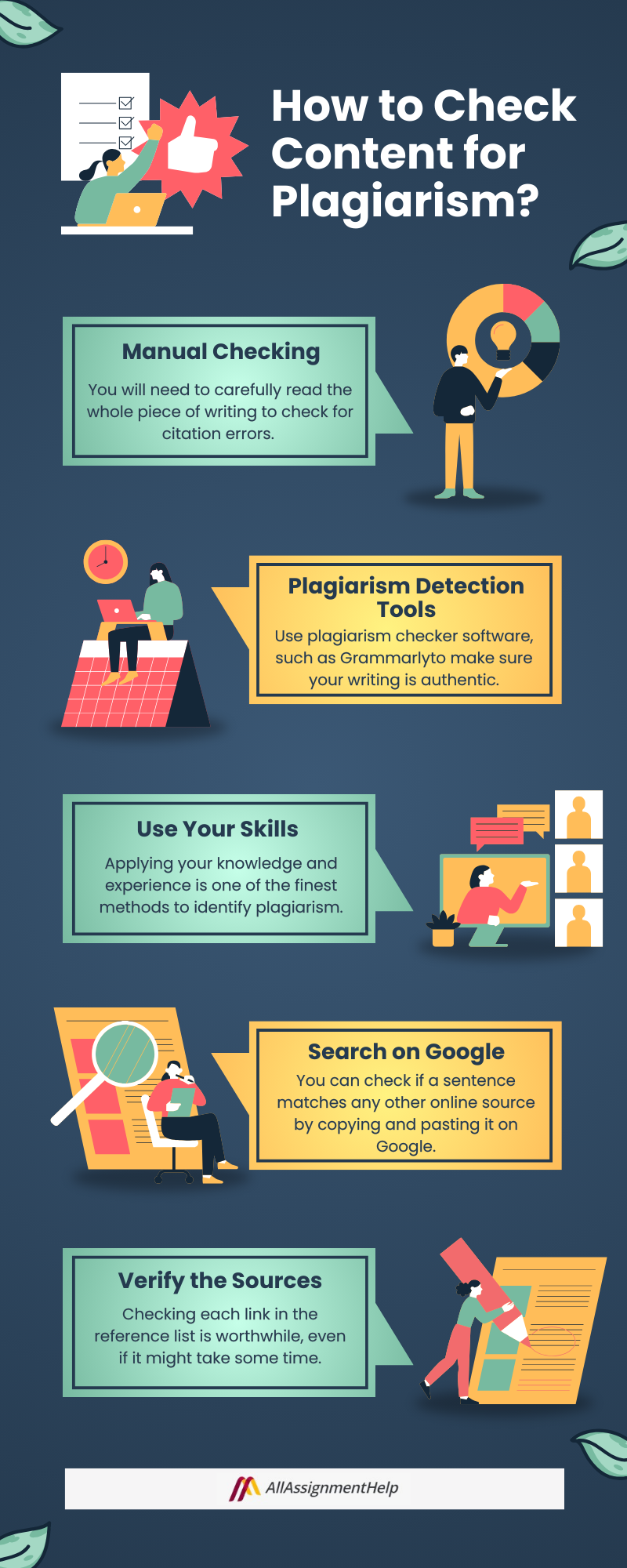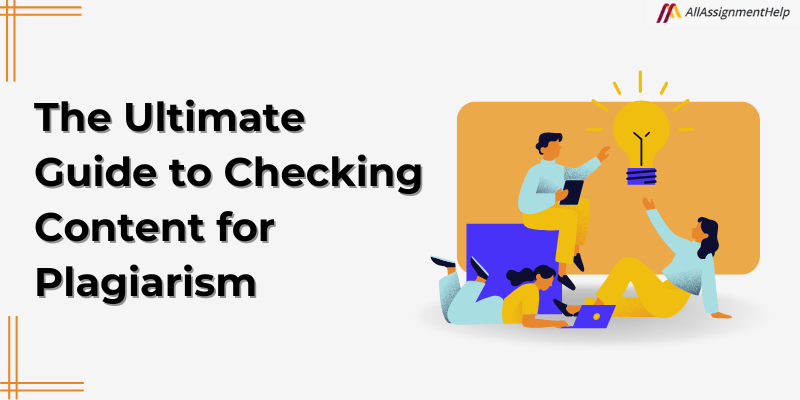Table of Contents
Creating unique work is more necessary than ever for preserving your academic reputation. However, many students struggle to avoid plagiarism, sometimes unknowingly. It can arise from over-reliance on sources, improper reference citation, or even unintentionally restating concepts commonly found in your study area. Thus, students need to maintain academic integrity and avoid plagiarism. After all, an original written piece is always preferable than a duplicate.
However, the question is: How to check content for plagiarism? In this blog of All Assignment Help, we have discussed everything you need to know about plagiarism, along with simple methods for checking your freshly created content for plagiarism. The purpose of this is to help students ensure that their work is free of plagiarism.
What is Plagiarism?
Plagiarism is when you use someone else’s words or ideas in your own writing without giving them the appropriate credit. When you cite a source wrongly, you might be unintentionally plagiarizing someone else’s work as your own. In any case, it’s seen as cheating. Therefore, you should stay away from it.
Copying and taking entire lines or text blocks exactly or with little modification from an article, research paper, or webpage is one of the most common types of plagiarism. However, you can avoid such plagiarism in your content or assignment by checking your work thoroughly using plagiarism checker tools available online. Also, you can take online assignment help from a reliable website that will help you in producing completely original work from scratch.
Read Here: All You Need To Know About a Plagiarism Checker
Common Types of Plagiarism
Research indicates that 40% of students admitted to plagiarizing without being aware of the consequences. Thus, they risk suspension, term failure, financial penalties, etc. You should be aware of a few different types of plagiarism to help you avoid encountering them in your assignment:
Direct Plagiarism
The author uses someone else’s statements exactly without giving credit. It might be one or two phrases, a few paragraphs, or even chapters. In the worst circumstances, a whole document is plagiarized.
How to Avoid Direct Plagiarism?
Giving credit to the original author and identifying direct quotes are the simplest ways to prevent information from being directly plagiarized.
For example, highlighting the text and enclosing it in quote marks might show that the passage was taken from another source.
Mosaic Plagiarism
In this particular case, paraphrasing someone else’s words without giving them credit is plagiarism. For example, a writer can copy passages or use a certain flow of phrases to convey the same idea. This situation might occur in more indirect ways when a writer, once more without giving credit, replicates another’s style or particular talking points.
How to Avoid Mosaic Plagiarism?
The most effective tactic against it is to proofread the work while editing. Analyse the work to determine if any parts look out of place or if the style is too similar to other material.
Mosaic plagiarism is particularly common in disciplines like as philosophy, literature, history, and the social sciences, where students often deal with intricate concepts and interpretations. Hence, it is suggested that students should take philosophy assignment help, literature assignment help, and so forth from an expert writer to avoid plagiarism in their assignments.
Self-Plagiarism
This might first appear unintentional or unproblematic, but it can have negative consequences in the real world. Even if you are the original author, you still need to use caution while using your work.
How to Avoid Self-Plagiarism?
Don’t use the same words in different segments. It’s important to make each item unique, even if its foundation is somewhat identical. If self-plagiarism is unavoidable, you have to get consent from all parties.
Accidental Plagiarism
Here, the author unintentionally borrows ideas or writing styles from another person. It can be challenging to identify and much more so to prove because this occurrence could coincide with others.
How to Avoid Accidental Plagiarism?
Verify your work twice or three times to check if it is detected by plagiarism detectors. Software checks can also assist in identifying any repeated portions. After that, you can change the wording until it is nearly unique.
However, when you quote material that is generally available, generic, and common knowledge, you are not charged with plagiarism. There is no need to reveal the source of your information if you have read it in several places or if your readers are likely already aware of it.
How to Check Content for Plagiarism?
How do you check for plagiarism in written content? Identifying duplicacy is necessary for upholding academic integrity and displaying your originality and innovation in academic work. Use these advanced approaches to assess whether the content is plagiarized or not:

Perform Manual Checking
You will need to carefully read the whole piece of writing to check for citation errors. It is preferable to provide in-text citations and references if the information you provide contains factual and statistical data.
When performing a manual check, start by carefully reading the content in question and searching for occurrences of words, sentences, or paragraphs that have been lifted and closely match the source material without the appropriate reference or acknowledgement. Furthermore, keep a close eye on the tone, sentence structure, and keywords to spot any possible plagiarism tendencies.
Try Plagiarism Detection Tools
Do you want to speed up the procedure? Use a plagiarism detector tool. Use plagiarism checker software, such as Grammarly or Copyscape, to make sure your writing is authentic. These tools can help in detecting any unwanted resemblances to previously published material and enable you to make the required modifications.
This step is necessary for preserving the uniqueness of your material and shielding your content from any copyright violations.
Use Your Personal Skills and Knowledge
Applying your subject-matter knowledge and experience is one of the finest methods to identify plagiarism in the written content. You can quickly identify any errors, mistakes, or out-of-date facts in the writing if you are knowledgeable about the subject.
Additionally, you can identify any well-known or commonly used sources that are not given credit or acknowledgment. Furthermore, you can figure out whether the material contributes any value, perspective, or insight to the subject by contrasting it with your own or other reliable sources.
Search on Google
Google search is a quick and easy technique to find plagiarism in the written content. You can check if a sentence or paragraph from the content matches any other online source by copying and pasting it. Quotation marks are another tool you can use to refine your search and find precise matches.
Also, you can try Google’s reverse image search to find out whether the photos in the content are unique or stolen from other websites. Those who are taking online classes also need to check their content for plagiarism and originality. They can do so via a quick Google Search. However, if they are unable to spot the accuracy of the information, they can take an online class help from a reliable website. These platforms often have expert teams who use advanced tools and techniques to detect plagiarism and enhance content quality.
Verify the Sources
It should be simple to identify plagiarism if you mention the sources. However, there might be chances that the sources and links are completely unrelated, and the author might just say that they were put there in error. On the other hand, some could be the real sources from which they got their information, while others might not be. Hence, checking each link in the reference list is worthwhile, even if it might take some time.
Go over the entire piece and mark any content that doesn’t appear to fit in with the rest of it in terms of tone, structure, and word choice. Keep an eye out for anything that doesn’t seem to be written by the same person.
By putting the aforementioned methods into practice, you can effectively uphold academic integrity and steer away of any sanctions that could eventually damage your name and career.
5 Easy Ways to Avoid Plagiarism in Your Content
It’s rather simple to avoid plagiarism in your work. Here are some ways to avoid duplicacy in your writing to assist you in avoiding this crime:
Add Quotations
When you take words straight from a source in your work, you should enclose them in quotation marks to show that they are not your own. This is one of the simplest yet visible strategies to avoid plagiarism. However, a direct quotation should also include a citation for readers to understand who the quote is from.
Paraphrase
Paraphrasing is a critical task where you have to maintain the essence of the original content while making it completely plagiarism-free. Students unable to paraphrase content often end up getting plagiarized content and risk losing their grades in academics. This also makes students think of alternatives where they can hire someone for their assistance and ask, can you please write my assignment for me? to avoid duplicacy in content.
Introduce Your Own Ideas
Explore your thoughts on the topic rather than simply repeating its words or concepts. Consider what original viewpoint or point of view you could present in your work? Remember that you must follow the rules to prevent copy-pasting, even if you are using a source’s words or ideas to support your argument.
Give Credit to Your Sources
When referencing someone else’s concept or phrasing, provide a reference in your work that includes the complete name of the source, the publication date, and any other citation information specified by the style guide you are using.
Ask for Feedback
If you are unable to see mistakes throughout your writing, you might find them by asking fellow students for feedback. One of the easiest methods to prevent plagiarism is to mark each other’s work for writing consistency, style, tone, grammar, and citations.
Learning how to avoid copy-pasting eventually requires daily practice along with increased awareness of what plagiarism is. It is important to understand that submitting plagiarized work might negatively affect your academic standing and performance, particularly on exams. Instead of risking your grades by submitting unoriginal work or resorting to unethical solutions, you should hire an online exam taker simply by asking, can you take my exam for me? There are lots of online resources and professional services accessible to assist you in maintaining your overall academic performance and enhancing your writing.
Also Read: Frantically Trying to Complete a Plagiarism-Free Assignment
Conclusion
Avoiding plagiarism ensures long-term academic performance as well as upholding the law and ethical guidelines. Keep in mind that stealing ideas from any other source might have far more negative effects than you would anticipate. Hence, it is recommended that you proofread your work before submitting it. However, it would be a smart decision to seek assistance from All Assignment Help if you are unable to write an original assignment on your own. We have expert assignment writers available to provide you with completely original, unique, and authentic work.
FAQs
Is there a free way to check for plagiarism?
Yes, you can use multiple software and tools available online to check for plagiarism for free. A few free plagiarism checkers are QuillBot, PapersOwl, and Paraphraser.io. These tools look for possible plagiarism in your writing by comparing it to online databases.
To what extent is plagiarism permitted in academia?
Plagiarism is generally prohibited in academia. The goal is 0% plagiarism, which means that all taken information should be appropriately credited and attributed, even if some educational institutes might allow for a little amount of similarities.
What is the simplest way to check for plagiarism?
Citing your sources is the simplest method for checking plagiarism. Plagiarism is evident when you utilize information from another source without giving credit. As a result, using original references or citations in your work is preferable.
